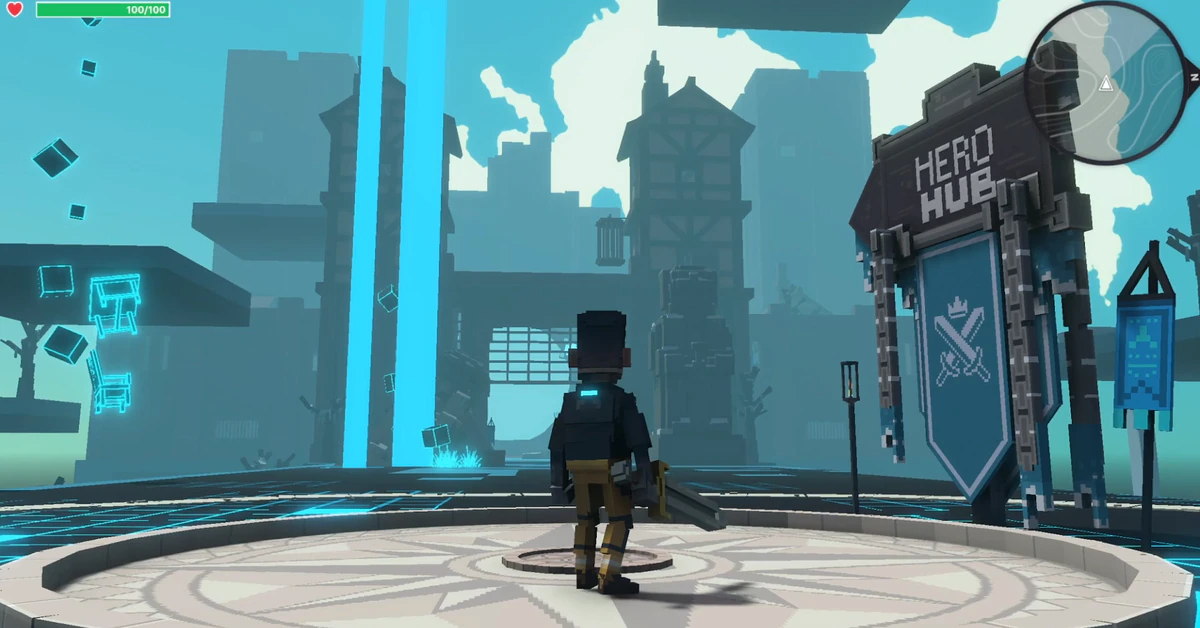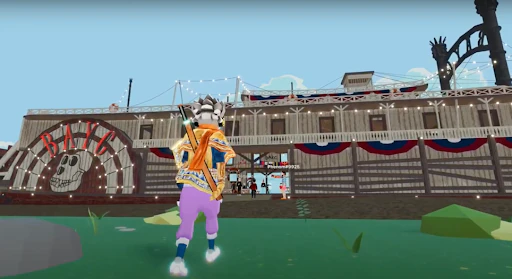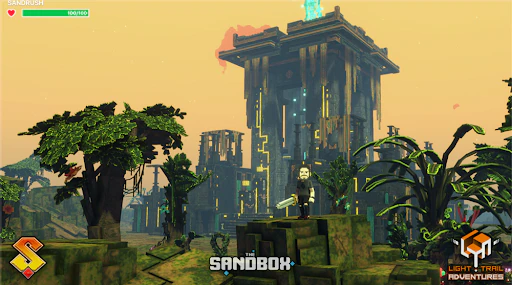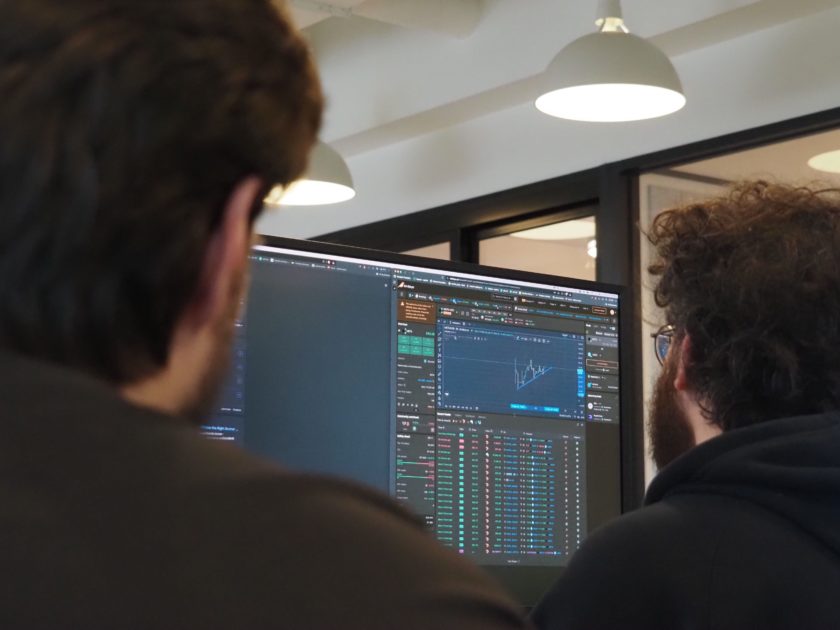If you want to play the role of God, you can’t overlook the fish. This is the implied message of a woman named Kelsei, aka “Pandapops,” who, over a video live-stream, gives a class on how to create digital worlds. Imagine an empty grid. Then the grid is filled with an aquarium, water and spooky fish. One of the fish has creepy eyes. One has a weird little tail. One looks like an alien.
Pandapops is upbeat and friendly, with a British accent and bright blue hair. “I really wanted the aquarium to look like there’s depth to it,” she explains.
For the next two hours she meticulously creates and tweaks her digital assets: She adds splash effects to the aquarium, she grows a flower and paints it an eerie shade of blue, she completes her “witch’s cottage.” (The asset’s meta-description: “Witch’s cottage: humble home for any aspiring woodland witch.”)
Jeff Wilser is the author of seven books including “Alexander Hamilton’s Guide to Life,” “The Book of Joe: The Life, Wit, and (Sometimes Accidental) Wisdom of Joe Biden” and an Amazon Best Book of the Month in both non-fiction and humor.
The work is strangely fascinating, like a 2021 version of watching Bob Ross paint. Soon the virtual world begins to expand. Pandapops finishes her aquarium, drops it into a tavern, then plunks the tavern itself into a village she has created, nestling it between a patch of trees.
The village is alive with people, and now it becomes clear that she’s designing a game. “This guy doesn’t give us quests yet, but he will,” Pandapops said of the barkeep, who, like all of the tiny avatars, look a bit like characters from the Lego movies. “That’s a bounty hunter,” she said. And soon we see our protagonist, the proverbial “player one,” who jogs through a courtyard with a cute little sword.
Pandapops is not a professional game designer. She’s not an employee of Epic, Sony or Electronic Arts. She’s using a program called VoxelEdits to create a game for The Sandbox, the newest blockchain-enabled metaverse, which launches its “public alpha” in late September.
And she’s not alone. Even before the launch of the metaverse, there have been over 100,000 downloads of Sandbox’s Game Maker engine (currently in beta), according to Sebastien Borget, the company’s co-founder and COO. “Our Game Maker requires no code, and you can make games without any experience,” Borget said. “That’s what we’ve been building for over three years.”
Read more: A Crypto Guide to the Metaverse
They’ve actually been building for 10 years. Sandbox, which originally launched in 2011 as a normal and non-blockchain start-up, represents the shift from traditional gaming to crypto-gaming. Sandbox started as a mobile app. Borget said that while the app was downloaded 40 million times, “the success of the game came from the users.” These users created 70 million assets. None of them earned a nickel, which is typically the case with traditional games like Minecraft and Roblox. After Borget learned of CryptoKitties, CryptoPunks and the user-owned wizardry of NFTs, he flipped the model of Sandbox to a decentralized blockchain metaverse, which would “turn players into creators” and then “help players and creators monetize all the content they make.”
Let’s back up. For the non-blockchain obsessed, the metaverse is still something of an obscure and opaque concept. That could soon change. The New York Times is running metaverse explainers; traditional brands like Sotheby’s and Coca Cola are dipping into the metaverse; and perhaps most consequentially, Mark Zuckerberg has hitched Facebook’s future to this virtual star, telling employees over the summer that the company’s overarching goal is to “help bring the metaverse to life.”
Which begs the question, what is the metaverse, exactly? Is it just one platform, or the sum total of all? Ask 10 different people at a crypto conference, and you’ll get 10 different definitions. “We should not expect a single, all-illuminating definition of the ‘Metaverse,’” writes venture capitalist Matthew Ball. “The Metaverse is best understood as ‘a quasi-successor state to the mobile internet’. This is because the Metaverse will not fundamentally replace the internet, but instead build upon and iteratively transform it.”
This is why the stakes are so high. Maybe today and tomorrow, the metaverse is just an online virtual world – like Decentraland, Crypto Voxel and The Sandbox – where you play a quick game, browse NFTs in an art gallery or have an online meet-up. This is the metaverse’s infancy. But in five or 10 or 20 years, perhaps the metaverse replaces much of what you do online, or even offline. Instead of a Zoom with your parents who live across the country, you join them for a metaverse game of tennis. Or instead of consuming the news on Twitter, maybe you’re dropped into a metaverse simulation of what’s happening in Afghanistan.
What path will we take to arrive at this metaverse future? Through the centralized, big tech route of Facebook? Or through a new decentralized model? As NFT artist “6529.eth” framed the question in a viral Twitter thread, “What we are playing for is whether our children will be fully free or residents in a digital company universe – with the illusion of free, but not really free.”
Covid, art, zombies
I first visited Decentraland a year ago. While I was intrigued by the world’s potential, it felt a touch under-populated. “I’ll be honest with you, we released a product before it was really ready,” said Sam Hamilton, who’s the community and events lead at Decentraland Foundation. “So we rolled our sleeves up.” The team pumped out more content, more events – art exhibits, conferences, music festivals, “quests” – and the crowds rolled in. Monthly users jumped from 7,000 to 70,000.
A few things help explain that growth: the boom in NFTs, the surge of play-to-earn crypto games and maybe even the pandemic. “COVID is a terrible, terrible thing, and we’ve all suffered greatly,” said Voxel Bunny, lead artist at Sandbox. (They use a pseudonym for anonymity.) “At the same time, going online is the norm. The metaverse feels even more approachable and appealing.”
The metaverse can be a home for art. And we now live in a world where celebrities like Steph Curry, Grimes, Paris Hilton, Jack Dorsey and Shawn Mendes are buying or minting NFTs. Suddenly the metaverse has newfound relevance, or even urgency. How do you showcase your art? How do you flaunt your Ape NFT? Decentraland’s Art District is one of the world’s standout features, creating a more immersive way to admire NFTs than to just stare at your phone. Artists are pouncing on the opportunity. The NFT collection “World of Women” – featuring 10,000 women, with an emphasis on diversity and inclusion – plans to buy a chunk of land in Sandbox, and then build a museum to hang paintings and animations.
“Is ‘metaverse maximalist’ a term yet?” asks Gordon Goner, one of the anonymous co-founders of The Bored Ape Yacht Club. Goner is a Metaverse Maximalist. (He just coined the term.) “I’m feeling fairly confident that we’re less than 20 years out from the “Ready Player One” experience,” said Goner. The Bored Apes are planting roots in both Decentraland and Sandbox; Goner said the club’s plan for Sandbox is still a “state secret,” but that you’ll be able to walk around in the metaverse as your three-dimensional “ape.” In Decentraland, you and your degenerates can hang in the Bored Ape Yacht Club riverboat casino.
And the metaverse, in turn, is investing in art. On Sept. 7, the Sandbox purchased one of the rarest Bored Apes, “The Captain,” for 740 ETH, or roughly $2.4 million. “We strongly believe that culture, whether games, music, visual arts, will be one of the pillars of the open crypto metaverse,” The Sandbox explained at the time. “We don’t just build and sell. We invest and help build the ecosystem.”
The building of that ecosystem is no longer just the work of spunky crypto startups, but also includes splashy brands. Sandbox’s partners include Atari, The Smurfs and “The Walking Dead.” Why zombies? “The Walking Dead” partnership gives at least two ways for Sandbox to create sticky content: First, the metaverse held “land sales” for people to buy coveted digital real-estate next to “Walking Dead” locations on the map, like the prison that featured prominently on the show. (Only in the upside-down world of crypto would land next to a zombie-prison be more valuable.) Second, the “Walking Dead” IP can be used as NFTs for games you create on Sandbox, boosting the crossover appeal.
Read more: The Metaverse Is Coming, Companies Need to Prepare
You’ll spot this same kind of mainstreaming in Decentraland. Hamilton said that in the “early days” of the metaverse (last year), the only brands they partnered with were crypto players like Binance, Skale and Kraken. Then came Atari. Then came Sotheby’s, which opened a virtual art gallery in the metaverse. As the head of sales at Sotheby’s, Michael Bouhanna, told theartnewspaper, “We see spaces like Decentraland as the next frontier for digital art.”
Then came Coca-Cola. Decentraland created a “can-top party” where you could swim inside a bottle of Coke and experience being inside the bubbles. It’s easy to see the mutual benefits: The metaverse gets compelling content, the traditional brands get engaged eyeballs. “We loved how Decentraland embraced the brand and created unique experiences,” a Coke executive later said. “We loved seeing NFT and metaverse artists take the iconicity of the brand and put a fresh, modern twist on it.”
And then came the games.
To (Axie) Infinity and beyond
Crypto play-to-earn games, such as Axie Infinity and Alien Worlds, have exploded. (You’ll find a fine primer here.) I tried playing Axie as a stunt for this article. You start by purchasing three Axies, cute little cartoon blobby creatures, that you then breed and send to battle. At the time of my attempt, the cheapest of these blobs cost $200, which put the entry fee at around $600 … and thus ended the shortest experiment in my writing career. Other gamers are bolder (or they got in before the prices skyrocketed), as Axie claims to have 250,000 daily active players and 90,000 ETH (or over $300 million) traded in its in-house marketplace.
“Everyone is looking at the success of Axie [Infinity] and saying, ‘Wow, this is definitely the future,’” said Decentraland’s Hamilton. He adds that it’s only part of the metaverse future, as “gaming isn’t everything,” but for many, it seems to be the real draw. Hamilton said that while events (such as the “To the Moon” music festival) provide spikes of traffic, play-to-earn crypto games have been “the most popular stuff on Decentraland on a consistent basis.”
And this takes us back to The Sandbox, to the live-streaming of Pandapops, and to the make-your-own-game ecosystem. The Sandbox is betting on games. Their “Game Maker” console allows you to create games (even complicated quest games) from scratch, such as the one Pandapops is working on, with the aquarium and the tavern: Your character will start the game with no memories, you will unlock the memories along your journey, and you’ll need to find a way to escape a maze. Eventually, you will free a once-evil ogre from the ogre king.
Honestly? The concept feels a bit flimsy, and Pandapops would later tell me with a laugh, “I’m not very good at the game-maker side of things.” (Her passion is live-streaming for blockchain gaming, which she does for both herself and Sandbox.) Yet some of the games are far more complex, thanks to an early decision by Sandbox. The company bankrolled a “Creator Fund,” recruiting digital artists to build the assets that would breathe life into this new metaverse.
“We wanted to make sure that when we open a virtual world, it’s not going to be like an empty mall,” said Borget. So they incentivized artists in two ways: 1) Compensation for creating the artwork, and then 2) If the artist is able to sell their art to someone on the Sandbox marketplace, they pocket 100% of the proceeds, with Sandbox taking an extra 5% commission. “It’s unbelievable. In all the years I’ve been making art, since 2007, I’ve never seen anything like it,” said Voxel Bunny, who once sold a Witch Tower for 3,150 SAND, or roughly $2,300 in today’s prices.
Then there’s the Game Maker fund. 450 artists and 54 studios, according to Borget, have been funded to create Sandbox games. One of these 54 studios is Sand Rush, co-founded by Christopher Weller, who goes by the alias of Necrobombicon. “I came into this industry as an artist,” said Weller. “I learned that Sandbox was willing to pay its artists with cryptocurrency.”
First he thought he’d bang out some assets himself, then he met other like-minded artists on the Sandbox Discord. They created a game studio, Sand Rush, that creates elaborate games like Jungle Rush, described as “a place of old magic, mystery and lore,” where “ancient technologies lurk in the shadows.” He has already found Sandbox to be lucrative. Sand Rush collaborated on the creation of “The Shrine of Truth,” a mystical structure meant as a centerpiece for someone’s digital land, and sold it for 100,000 SAND, or roughly $100k at current prices.
Beeple’s $69 million this is not, but now imagine a pipeline of artists who can sell their NFTs in the marketplace, which in turn can be used to build games. That’s already happening. Borget said that the Sandbox creator’s economy has topped $48 million in volume (pre-launch), with over 350,000 wallets created.
What’s in this Sandbox marketplace? As of the time of this writing, you could buy a “pool party cool guy” for $42, a beach van for $787, a tree house $840 and a “crazy pool” for $525 (it’s not at all clear how the pool is crazy). This is at the low-end. For those on a more luxurious budget, you might want to consider an “ancient magic statue” for $3,150 (it is neither ancient nor magic), a “robot incubator” for $10,429 or a “summer rock metal band” for $5,214.
On the one hand, sure, to state the obvious, you can hire an actual rock metal band, which plays actual music, for less than $5,214. Then again, this marketplace enables creators to be compensated for their work. “It’s an exciting moment in history, where suddenly a new sphere in work appears,” said Voxel Bunny. “Suddenly there are new jobs that were not here a few years back.”
This feels refreshingly concrete. While much of the capital sloshing around the crypto ecosystem is difficult to understand or process, here’s an example of the rising tide of crypto prices directly helping artists. This could have a domino effect. First Voxel Bunny creates the Witch Tower and sells it for $2,300, then perhaps a buyer – a game creator – uses it in a quest that she herself will monetize. Now the players of this game will earn crypto as they try and solve the quest, completing the virtuous cycle. Sure, speculation and profit-seeking is part of the model, but is that really any different than the profit-seeking of billion-dollar gaming corporations?
Enter Darth Vader
Decentraland or The Sandbox? Or maybe Crypto Voxels? Or another of the many metaverse projects popping up, such as Realm or Neon District? Which one “wins”? The various metaverse projects, at least for now, seem to view each other as more cooperative than competitive. “I don’t think it’s a winner-take-all situation,” said Decentraland’s Hamilton, who thinks that just as there’s room for a Twitter and Facebook and Snapchat and Tik-Tok – each playing a different role – there will be space for multiple platforms in the metaverse. Sandbox’s Borget said that “each one has a different strength,” with Decentraland more aligned with events, Crypto Voxels as “more simple and accessible,” and Sandbox with gaming.
But finally, of course, we have the issue that looms over all of this. It’s what I’ll call The Darth Vader Scenario.
In a weird coincidence, on the very same day I spoke to many of these crypto-metaverse advocates, I happened to visit a buddy who wanted to show off his new “Oculus,” a virtual reality headset. It’s made by Facebook. It’s the gateway to Horizons, Zuckerberg’s plan for the metaverse.
I slipped on the VR goggles, completed a quick tutorial, and then gasped as I found myself on the top of a skyscraper.
A virtual city enveloped me. Blue sky, honking cars, planes overhead – it all looked real. Maybe not quite photorealistic, but real enough so that when I peeked over the edge of the skyscraper, my stomach lurched at the sight of the ground far below. I don’t have a fear of heights. And my brain knew that in reality, yes, of course, I was safely in my friend’s living room. That didn’t matter. When I “walked the plank” to step out from the edge of the skyscraper, looking down at the 100-story drop beneath me, I was both terrified and thrilled.
Read more: Inside Alien Worlds, the Biggest Game in the Metaverse
“Jump off the plank!” My friend urged me.
“No way.”
“Do it!”
Below me was certain death. I hesitated. What tipped me over the edge, literally and figuratively, was the sound of my friend’s young son in the background, laughing at my cowardice. Finally, I jumped off the edge of the plank … and of course, landed safely on the carpet of the living room. It was exhilarating.
I then rode a virtual roller coaster, played a virtual shooter game, and then – to the delight of my inner 12-year-old – played a virtual reality (VR) game of Star Wars, complete with Darth Vader himself. I wanted to buy an Oculus. The game and the VR tech is not particularly new, but it’s one thing to know that in the abstract, and it’s another to see it and feel it in your bones.
While a blockchain metaverse might win every argument on the principles – empowering players, decentralizing the tech, actual ownership of digital assets– in practice, for the average user, how does that stack up to the easy lure of flying through the air or clashing lightsabers with Darth Vader? The tech behemoths have seemingly every advantage: bottomless resources, easy access to brands (Avengers metaverse?) and, in the case of Facebook, a built-in user base of 2.8 billion. Blockchain is still the underdog.
I thought back again to Pandapop’s humble aquarium, with the creepy fish and the splash effects that she painstakingly added. I thought of her simple game where you need to escape a maze and slay the ogre king. It’s true that Pandapops could own that aquarium, monetize her game and claim a legitimate sense of empowerment. (It’s also true, of course, that the blockchain games will likely get more sophisticated in time, especially as creators are incentivized to make more.)
But will the average gamer care?
Just look at the internet. For decades, most of us have chosen – whether we knew it or not – the sugary speed and convenience of big tech centralization. Even if it cost our privacy or agency, we enjoyed our stored passwords, auto log-ins and using Google, Apple, Facebook et al. to make our digital lives smoother.
We preferred a centralized Darth Vader to the decentralized maze. Time will tell if we choose differently in the metaverse.







